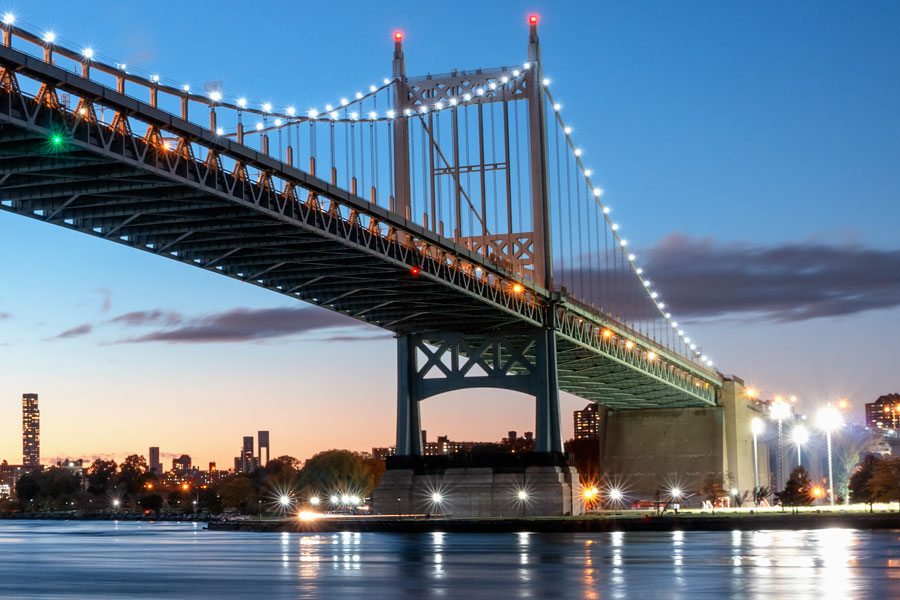Triborough Bridge (Robert F. Kennedy Bridge)

The Triborough Bridge, officially renamed the Robert F. Kennedy Bridge in 2008, is one of New York City’s most complex and important crossings. Unlike other bridges that link just two boroughs, the Triborough is a three-span system connecting Manhattan, Queens, and the Bronx. Opened in 1936, the bridge has served as a critical piece of New York’s transportation infrastructure, offering direct access between boroughs and providing a major route for drivers traveling to and from Long Island.
History
- Planning & Construction: Conceived during the 1920s, the Triborough Bridge project was delayed by the Great Depression before being revived under the leadership of Robert Moses. Construction began in 1929 and resumed in earnest in the early 1930s with federal funding.
- Opening: The bridge was officially opened on July 11, 1936, with President Franklin D. Roosevelt dedicating it as part of a major public works effort.
- Renaming: In 2008, the Triborough was renamed the Robert F. Kennedy Bridge in honor of the late U.S. Senator, though many New Yorkers still refer to it as the Triborough.
Design & Features
- Bridge System: The bridge is actually a network of three separate spans:
- Total Length: Approximately 2,780 feet for the East River crossing, with multiple additional spans.
- Roadway: Eight lanes of vehicular traffic across the entire system.
- Tolls: All-electronic tolling via E-ZPass or Tolls by Mail.
Importance for Long Island Travelers
The Triborough Bridge is especially important for drivers from Long Island heading to:
- The Bronx and New England – connecting to the Major Deegan Expressway (I-87), Bruckner Expressway (I-278), and I-95.
- Upper Manhattan – via the Harlem River Drive and FDR Drive.
- Randalls and Wards Islands – recreational destinations in the East River accessible only via the bridge.
Because of its strategic location, the bridge helps distribute traffic between boroughs and reduces dependence on the Midtown Tunnel, Queensboro Bridge, and Bronx crossings.
Nearby Landmarks
- Queens Side: Astoria Park, home to tennis courts, a track, and one of New York’s oldest swimming pools.
- Manhattan Side: East Harlem, a culturally rich neighborhood with historic architecture and vibrant dining.
- Bronx Side: The Port Morris and Mott Haven neighborhoods, with easy access to Yankee Stadium via connecting highways.
Q&A – Triborough Bridge
Q: Why is it called the Triborough Bridge?
A: Because it connects three boroughs: Queens, Manhattan, and the Bronx.
Q: When was it renamed the Robert F. Kennedy Bridge?
A: In 2008, though most New Yorkers still call it the Triborough.
Q: Does the bridge connect directly to Long Island highways?
A: Yes. On the Queens side, the bridge connects to the Grand Central Parkway, offering a direct route to the Long Island Expressway and other major roads.
Q: Can pedestrians or bicycles cross the Triborough Bridge?
A: Yes, pedestrian and bicycle paths are available, primarily on the East River span.
Area Snapshot
| Feature | Details |
|---|---|
| Opened | 1936 |
| Bridge Type | Suspension / Cantilever system |
| Main Spans | East River, Harlem River, Bronx Kills |
| Lanes | 8 total |
| Operator | MTA Bridges & Tunnels |
| Primary Connection | Queens ↔ Manhattan ↔ Bronx (via Randalls Island) |
The Triborough Bridge stands as one of New York City’s most ambitious engineering projects and remains a cornerstone of the city’s transportation network. By linking three boroughs and providing crucial connections for Long Island travelers, the bridge continues to serve millions of commuters and visitors each year. Its iconic design and strategic location make it not only a functional crossing but also a lasting symbol of New York’s infrastructure ingenuity.

